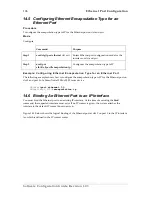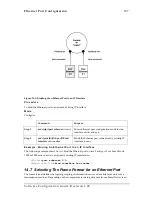
100
NAPT Configuration
13.4 Creating a NAPT Profile
A NAPT profile can be bound to the global interface. The profile defines which packets to ports
destined to the global interface should be forwarded to which hosts on the local network.
Furthermore a host can be specified to get all ICMP messages, namely the ICMP default server.
This command creates and enters new profiles, enters existing profile or removes existing profile.
After entering the profile, the commands
static
and
icmp default
are available to configure the
profile.
Procedure
To create the new NAPT profile
Mode
Configure
Command Purpose
Step 1
node
(cfg)#profile napt
name
Creates the new NAPT profile
name
Example: Creating a NAPT Profile
The following example shows how to create the new NAPT profile
access
. Use the following
command in configuration mode.
SN(cfg)#
profile napt access
13.5 Adding a Static NAPT Entry
The command
static
defines that all packets arriving on the global interface at
port
are forwarded to
the host with IP address
ip-address
in the local network This and similar commands can be entered to
build up a static port translation table that is used by the router.
Modifications to static entries of a bound profile immediately reconfigure the static port-mapping
table of the router. However if you remove a static entry, the router continues forwarding packets to
the previously configured host in the local network until the connection terminates or a timeout
occurs.
Procedure
To add a static NAPT entry to the NAPT profile
Mode
Configure
Command
Purpose
Step 1
node
(cfg)#profile napt
name
Selects the existing NAPT profile
name
for
configuration
Step 2
node
(pf-napt)[
name
]#static {tcp
| udp}
port
ip-address
Defines that all packets arriving on the global
interface at port
port
are forwarded to the host
with IP address
ip-address
in the local network
Software Configuration Guide, Revision 1.03
Summary of Contents for SmartWare R2.00
Page 2: ......






























